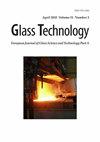碳质矿物作为腐蚀产物在瓶子表面
IF 0.3
4区 材料科学
Q4 MATERIALS SCIENCE, CERAMICS
Glass Technology-European Journal of Glass Science and Technology Part a
Pub Date : 2020-12-12
DOI:10.13036/17533546.61.6.OZCAN
引用次数: 0
摘要
在腐蚀过程中,随着玻璃表面与水之间离子交换的进行,表面的化学结构发生变化,形成不同的结构层。通过各种分析技术,如EPMA, XRD, FT-IR, TG-DTA和ICP-OES对这些层进行了表征。在最外层沉积层中发现了方解石(CaCO3)、短云母(Na2Ca2(CO3)3)和银云母(Na2Ca(CO3)2) 3种碳酸盐矿物。采用特殊的测试方法,对影响贫碱富硅凝胶层形成的关键参数进行了研究。亚甲基蓝溶液与凝胶层的硅烷醇发生反应,留下蓝色的色调,其强度随腐蚀程度的变化而变化,随着硅烷醇基团数量的增加而增加。色标是用来确定腐蚀程度的,其结果与其他已知化学分析方法的结果相关联。研究了退火条件对表面耐化学性的影响,以及瓶形对潮湿环境下冷凝水的影响。描述了腐蚀表面的酸处理和再退火的结果。本文章由计算机程序翻译,如有差异,请以英文原文为准。
Carbonaceous minerals as corrosion products on the surface of bottles
During the corrosion process, as the ion exchange between the surface of the glass and the water progresses, the chemical structure of the surface changes and different structural layers are formed. These layers are characterised by various analytical techniques such as EPMA, XRD, FT-IR, TG-DTA and ICP-OES. Three carbonate mineral species namely calcite (CaCO3), shortite (Na2Ca2(CO3)3) and nyerereite (Na2Ca(CO3)2) have been identified at the outermost deposition layer. Critical parameters that affect the formation of the alkali depleted and silica enriched gel layer are investigated using some special test methods. Methylene blue solution reacts with the silanol groups of gel layer leaving a blue tint behind, the intensity of which varies with the extent of corrosion as the amount of silanol groups outcropped due to the increase of the porous structure area. A colour scale is developed to determine the level of corrosion and the results are correlated with the results of other known chemical analysis methods. The effect of annealing conditions on the chemical resistance of the surfaces and the role of the shape of the bottles on the water condensation at humid atmosphere are studied. The results of acid treatment and re-annealing of the corroded surfaces are described.
求助全文
通过发布文献求助,成功后即可免费获取论文全文。
去求助
来源期刊
CiteScore
0.30
自引率
0.00%
发文量
0
审稿时长
>12 weeks
期刊介绍:
The Journal of the Society of Glass Technology was published between 1917 and 1959. There were four or six issues per year depending on economic circumstances of the Society and the country. Each issue contains Proceedings, Transactions, Abstracts, News and Reviews, and Advertisements, all thesesections were numbered separately. The bound volumes collected these pages into separate sections, dropping the adverts. There is a list of Council members and Officers of the Society and earlier volumes also had lists of personal and company members.
JSGT was divided into Part A Glass Technology and Part B Physics and Chemistry of Glasses in 1960.

 求助内容:
求助内容: 应助结果提醒方式:
应助结果提醒方式:


